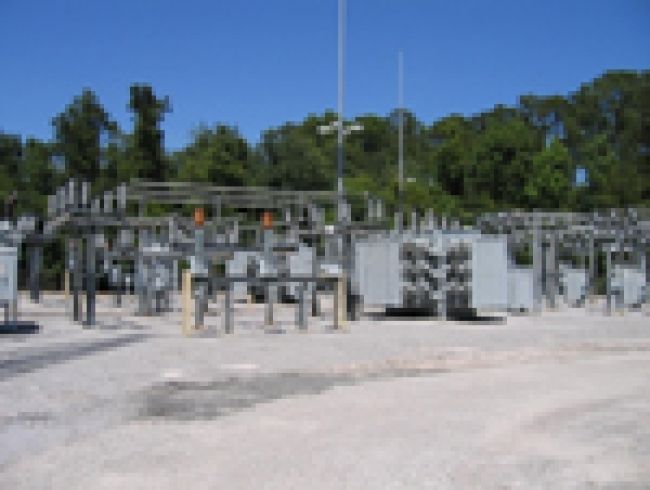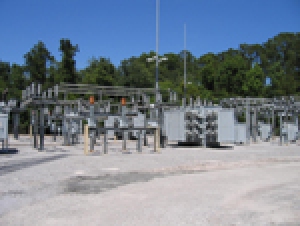
Safety Awareness for Substations

There are a number of hazards unique to substations. The substation safety information found in this article is drawn from 30 years of personal experience as well as industry best practices, regulations, codes and company policies. During my time working in substations, I have seen some horrible accidents and hope the following lessons I’ve learned will prevent other people from having to experience injury or death.
A Lesson for Beginners
One thing I remember thinking as I walked into a substation for the first time is that it would be pretty easy for a person to get killed inside the facility. As a groundman, I was quickly taught how dangerous substations are, especially for me – I am 6 feet 8 inches tall and can reach up to 8 feet with my feet flat on the ground.
In 1980 my fellow workers had an interesting way of teaching me about the dangers of my height. When I arrived at a distribution substation job site for the first time, I got out of the van, stood up and stretched. I was immediately tackled to the ground by a journeyman and two apprentices who told me that I would have to stop that practice. They believed I was expendable, but were concerned that I might take one of them with me if I blew up the place. Each day they reinforced this lesson by duct-taping my arms to my torso just above my elbows so I would remember to never stretch again inside a substation, or carry tools, equipment or other objects above my shoulders while inside. It was a crude way to make a point, and I would strongly suggest that method not be used today, but it was effective. To this day, whenever I point out something in a substation, my hand never gets above my shoulders.
Nowadays I typically teach people new to energized substations to put their hands in their pockets. If they take their hands out of their pockets without telling me, they will be removed from class for the day; this practice, which I consider an industry best practice, is that important in some of the older distribution substations. Fortunately, substation construction standards and the National Electrical Safety Code have changed over the years to help reduce hazards.
Personnel Protection
Most company policies require you to notify the dispatch center or substation owner before entering and leaving a substation, which is a good industry practice for several reasons. First, if there is a switching process in progress, the dispatcher will notify you. Proper notification will ensure that you don’t bounce off the fence trying to get out because someone opened a 500-kV switch over your head or closed a circuit breaker you were inspecting. Second, if an incident occurs and you need medical assistance, the dispatcher will know where you are or at least have an idea where to start looking for you. Finally, if someone gets into an energized conductor, the dispatcher will know not to re-energize the circuit until they verify you are in the clear.
When it comes to personal protective equipment, most of us know the basic requirements, but as a refresher, approved hard hats, safety glasses and work shoes must be worn at all times when you are inside a substation. Flame-resistant clothing to protect against arc flashes shall be worn where applicable.
Barricades should be in place to warn personnel of hazards. Barriers should be used to prevent personnel from entering hazardous areas such as open control cable ditches or broken wire trough covers. When high-voltage testing on substation equipment takes place, it may be policy to guard the area depending on the exposure to personnel.
Coming and Going
Standard substation security must be observed at all times. When entering and working in a substation, all gates shall be closed; depending on your company’s policy, the gates may also need to be locked. When leaving, all gates shall be closed and locked. Once inside the substation, you need to ensure the grounds connecting the gate to the fence are in place. Also, before you touch any piece of equipment, check to see it is properly grounded. If the equipment is not grounded, stop and consider your two choices: either call someone to fix it or – if you are equipped and trained – install a temporary ground jumper and treat it like it is energized at full primary voltage using proper live-line equipment. I have tested in-service grounds with a clamp-on amp meter and occasionally registered 8-12 amps. Remember, it’s likely you are standing on a concrete foundation and excellent ground.
Only trained and authorized personnel are allowed in substations. Anyone temporarily entering a substation, such as delivery personnel, must be escorted by a crew leader or supervisor at all times. Many years ago I was in a transmission substation with three apprentices when we were almost killed. A rental company driver – who was in the process of delivering an aerial device for another crew on a flatbed truck – entered the substation unescorted. He followed the designated roadway, but because the exhaust stacks on his truck were so tall, the truck was very close to making contact with a 138-kV tap coming down from a switch to a breaker. Before he made contact, I ran over to the truck driver and stopped him. He, like most of the general public, had no idea about the hazards found in substations.
Operating vehicles in substations requires attention to detail. It’s important to note where the roadways are and where vehicles can and cannot be driven. Obviously, drivers of high-profile vehicles need to be aware of high-voltage equipment at very low levels even on marked roadways. High-profile vehicles should be escorted by an observer in energized areas. It’s also necessary to know where vehicles can cross over raceways and cable/wire troughs. Marked roadways usually have reinforced crossover areas so be sure not to drive on any raceway or cable trough not marked for crossover. Finally, because everything in a substation looks the same – gray gravel, gray fencing, gray columns and gray structures – try not to back up your vehicle unless you have a spotter. Instead, park your vehicle in such a way that you can pull out without backing up.
General Safety Practices
Following are some other general safety procedures that should be observed in substations:
• Mobile equipment – such as aerial bucket trucks, digging equipment and cranes – shall be grounded to the substation ground grid in accordance with established rules and regulations. I suggest using 4/0 stranded copper.
• Only trained, authorized personnel are allowed to work inside or near capacitor banks, reactors and other fenced-in areas inside a substation. Some people may not be aware that these metal structures may be energized.
• Remember to guard against the hazards of live or induced voltage. If the need arises, ensure equipment is switched out, tagged out, tested for voltage and grounded.
• Exercise caution around control house equipment; some of it is very sensitive to vibration.
• Observe hazard warnings regarding battery systems in the substation.
• As a general rule, it is not a good idea to store any equipment or material in a substation. An untrained employee sent to retrieve the material could get hurt. Additionally, if equipment in the substation blows up, it may also damage stored equipment.
Living, Breathing Hazards
Another substation hazard to watch out for is the living variety – insects, reptiles and animals. Fortunately, most equipment today is covered with material designed to prevent animals and other creatures from accessing it. If you come upon equipment or a structure that isn’t covered with this material and there is an animal on it, move away. Small animals can cause big explosions.
In the South, wasps build large nests in steel structures, usually within 15 feet of the ground. This is mostly an annoyance unless you’re allergic to wasp and bee stings. Spiders, including black widows and brown recluses, are also abundant and tend to hide in control rooms, wire troughs, equipment cabinets and handles. Frogs typically are not dangerous. They do, however, provoke an interesting response in humans when, at 4 a.m., you open a circuit breaker or transformer cabinet and something cold, wet and slimy drops onto your hand. Reptiles have always been a problem in substations, and I have had several encounters with snakes. Once, I was responding to a station alarm at 2 a.m. When I opened a circuit breaker cabinet door, I woke up a 4.5-foot-long rattlesnake that was in the bottom of the cabinet next to the heater. I quickly jumped back about 10 feet – an automatic human response – and eventually persuaded the snake to leave with a switch stick.
As I mentioned at the beginning of this article, the information presented here comes from a wide variety of sources. Remember that it’s not important where accurate information comes from if it can save a life. Share your lessons with others and stay safe.
About the Author: R. Scott Young, CUSP, has worked in the power industry since 1978. He is a certified substation technician and circuit breaker technician. Young owns Industrial Safety Institute (www.industrialsafetyinstitute.com) in Tampa, Fla., and travels worldwide conducting electrical, technical and safety training programs. He has also conducted extensive audits for numerous private and government entities and utilities. Young is an affiliate instructor for the University of South Florida OSHA Training Institute. He can be reached at rsyisi@gmail.com.

